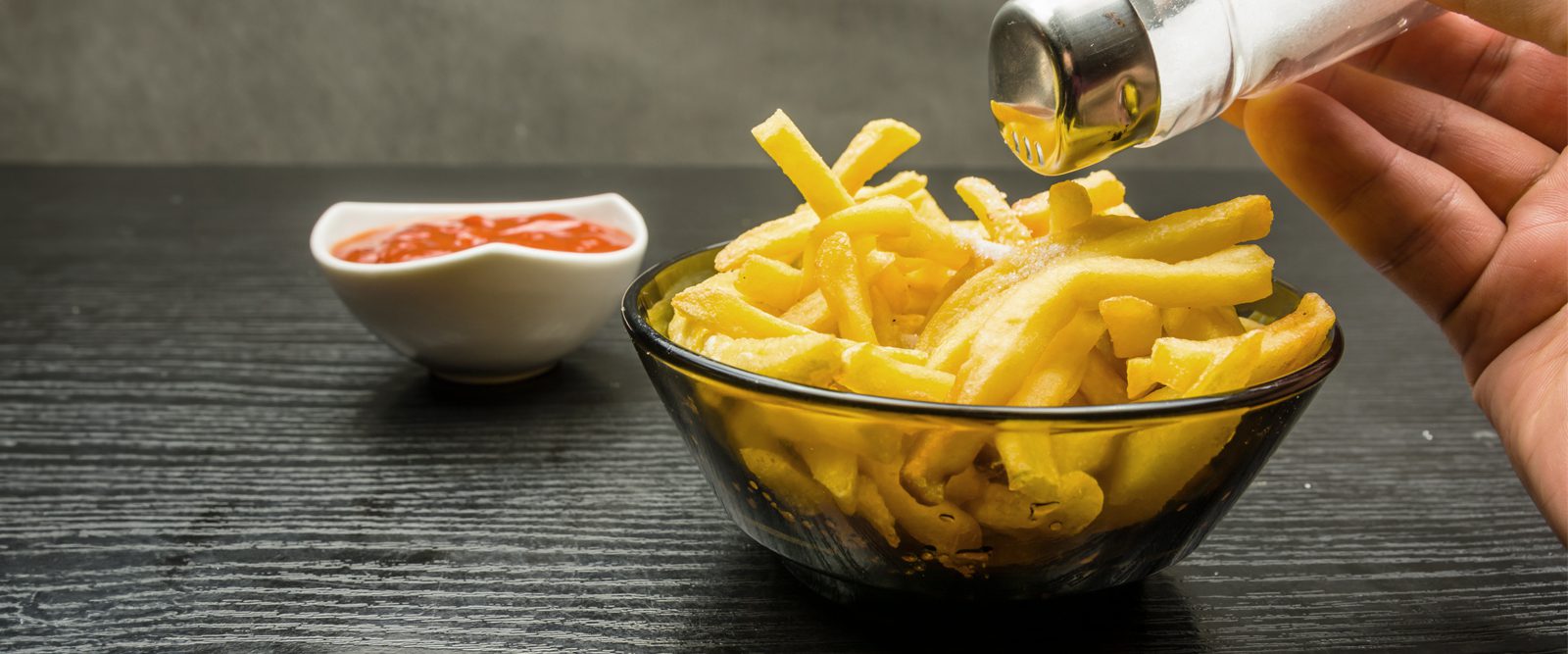How Much Salt is Too Much?
A cardiologist and a dietitian break down the health risks that come with overconsuming salt, and the best ways to cut down on sodium in your diet.

When a meal is bland, it’s common practice to reach for the salt. But how much salt is too much? The American Heart Association (AHA) recommends no more than 2,300 mg a day — equal to about 1 teaspoon of table salt — with an ideal limit of less than 1,500 mg for most adults. However, according to the Food and Drug Administration, Americans consume an average about 3,400 mg of sodium per day.
The reason that salt intake matters is because sodium impacts blood pressure, says Dr. Jessica M. Peña, a cardiologist at NewYork-Presbyterian/Weil Cornell Medical Center. Consuming too much salt can cause the body to retain fluid and raise blood pressure. High blood pressure, or hypertension, strains the heart and increases risk of heart attack, stroke, and kidney damage. According to the AHA, an estimated 121.5 million adults in the United States have hypertension.
The good news is that reducing salt in your diet is an effective way to reduce blood pressure. A recent study found that cutting out 1 teaspoon of salt each day is as effective at lowering blood pressure as medication.

Dr. Jessica M. Peña
“Especially as we age, we need to pay attention to how much sodium we consume,” says Dr. Peña. “It’s a powerful non-pharmacologic way of reducing our cardiovascular risk.”
“It can be alarming to realize that even a pinch of salt could be contributing to a large portion of our daily intake goals,” added Gabrielle Gambino, a clinical dietitian who specializes in heart failure at NewYork-Presbyterian/Weil Cornell Medical Center.
Health Matters spoke with Dr. Peña and Gabrielle to learn more about what can happen when we consume too much sodium, and how to have a healthy relationship with salt.

Gabrielle Gambino
What is the difference between salt and sodium? Why do we need salt?
Dr. Peña: Sodium is a mineral and electrolyte that helps regulate the balance of fluid content in our bodies. Our brain, nervous system, and muscles all need sodium. Salt, meanwhile, is a compound, the combination of two minerals: sodium and chloride.
Gabrielle: The body needs sodium, a component in salt, in order to carry out normal day-to-day processes, like supporting nerve signal transmissions and proper muscle function, aiding circulation, facilitating the absorption of other nutrients like calcium and iodine, and regulating blood pressure.
Some people need more sodium than others. Athletes, for example, tend to sweat more, leading to loss of sodium and other electrolytes. To make sure their nerves and muscles are functioning properly, they might need to increase their salt intake, but this varies depending on activity level, duration, and the amount of sweat they normally produce.
What are some of the risks of too much sodium?
Dr. Peña: Consuming high amounts of sodium can raise your blood pressure over time and lead to cardiovascular disease, heart failure, stroke, and even kidney function issues.
Gabrielle: Our blood pressure is very well maintained by hormonal signals; our organs tell each other what they need. Sometimes, eating too much salt can dysregulate this homeostasis, making your kidneys work harder to eliminate the sodium and making your heart work harder to pump all that fluid out of your body. Avoiding that dysregulation is key to keeping our organs healthy and working efficiently.
4 Tips to Cut Down Sodium in Your Diet
1. Eat High-Potassium Foods
“It’s helpful to embrace the dos, rather than dwelling on the don’ts,” says Dr. Peña. “Adding more high-potassium foods to your diet, like nuts, beans, spinach, avocado, sweet potatoes, and tomatoes, can help counter the effects of sodium.”
2. Look for Low-Sodium Products
Dr. Peña also recommends looking for low-sodium versions of the products you love and reading labels when you’re browsing in the supermarket.
“If it’s designed to stay on the shelf for a long time, it’s likely high in sodium. One of the original uses of salt was to preserve meat and keep food stable,” she explains.
Generally, around 140 milligrams of sodium per serving is considered to be a low-sodium option.
3. Shop the Periphery of the Supermarket
“I usually tell patients to shop around the periphery of the grocery store as much as possible because that’s where you’ll finding the non-processed, more natural foods,” says Gabrielle.
In the middle of the store, which is the non-refrigerated section, you’ll find most of the boxed, canned, and prepackaged foods. Those foods tend to have more preservatives and sodium. You don’t need to completely swear off canned foods, Gabrielle says, but if you rinse the contents before eating, you can wash away up to 40% of the sodium.
4. Flavor Food with Herbs and Spices
Gabrielle recommends flavoring foods with herbs and spices rather than salt. “For beef, season with garlic, dill, curry or even onion powder; and for fish, try black pepper, lemon juice, or turmeric,” she says.
What are some foods and products that contain a lot of sodium?
Dr. Peña: People might think that most of the sodium we consume comes from sprinkling salt on our food, but around 70% of the sodium we eat comes from processed foods and restaurant meals.
Also, there’s not really a difference in sodium levels between table salt, sea salt, and kosher salt. Clever marketing might lead people to think that some are healthier than others, but in the end it’s all sodium.
Gabrielle: Ketchup, barbecue sauces, salad dressings, and other condiments that many people use daily tend to be very high in sodium. A lot of breads have more salt than we may realize, so sticking to one or two pieces per meal is advisable.
Is it possible to change a person’s palate or preference for salty food?
Dr. Peña: Sodium is a sneaky thing. I think most of us don’t think about it, and it can be hard to change your preference; but the body does adapt, and it’s never too late to adjust to a lower sodium diet. The biggest takeaway is to eat less processed, prepackaged foods.
Gabrielle: Some studies show that if you’re exposed to a high-sodium diet when you’re younger, you’re more likely to develop a taste for very salty foods as an adult. But it’s possible to change that preference over time; you just need to be very patient with yourself and realize that it might take weeks for you to adapt. I’ve seen heart failure patients make the transition, and down the line, they tell me they can barely stand salt anymore.
